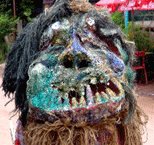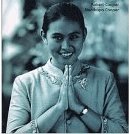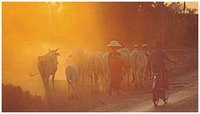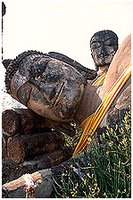Phi Ta Khon festival reflects the local Isan belief in ghosts and spirits. Held once a year in Dan Sai district in Loei Province, it is part of a grand merit-making festival known as the "Boon Luang" festival. Part of the activities includes young men dressd up as "spirits" wearing long trailing costumes made from colourful strips of cloth sewn together. The origins of the Phi Ta Khon Festival can be found in the tale of Lord Buddha's last incarnation before attaining Enlightenment. In Buddhist accounts, it is said that when Prince Vessandara, the Buddha's penultimate incarnation, returned to his city, it was such a joyous occasion that the village spirits came forth to join the welcoming parade. This very colourful and vibrant Phi Ta Khon procession is the central focus of the celebrations.
The first day of the festival involves religious ceremonies performed at the temple while the second day is a parade of young men in hideous-looking Phi Ta Khon mask - the masks are made of dried sticky rice painted in bright colours.
The clanging sound of the square cowbells worn around the waist announces the presence of the spirits who wield phallic-shaped long-handled swords decorated with red paint. The good-natured, fun-loving spirits mingle among the crowd, teasing and amusing all who take part in the procession. Spectators and visitors are welcome to join in the fun.
Phi Ta Khon is celebrated largely by young men who dress as spirits to parade a sacred Buddha image and tease villagers, and monks reciting the stop of the Buddha's last great incarnation before attaining Enlightenment The festival is held during May or June every year.
There is a remote village in Northeastern Thailand that is famous for being haunted. Abundant evidence for this claim exists -- phantoms float from walls in Thai restaurants, leer out of luridly colored travel posters, and leap from shadowy margins of tourist guidebooks -- yet few outsiders have witnessed the dazzling demon denizens of Dansai. In this village, during the Siamese "day of the dead," naughty ghouls roam the streets freely and actually enjoy posing for photographs. They materialize for the annual Phi Ta Khon (ghosts with human eyes) festival, which is usually observed in June or July. The exact date is divined not far in advance by the most revered and feared member of the village, Jao Paw Guan, a male maw duu (seer) and leader of the sacred portions of an otherwise profane party.
The easiest way to get to Dansai is to fly to Udon Thani and set off by car down country roads to the nearby province of Loei. The scenery along the way is clean and green; an enchanting landscape of farms, limestone karsts in misty distance, and rolling hills bordering Laos. The cool mountain air there is home to Thailand's famous (only) winery, Chateau de Loei. You can drive through the rolling vineyards for free, but you may be spooked to learn that there isn't any wine tasting, or even a Chateau (a phantom of marketing). There is a small resort next to the winery offering basic accommodation and Dansai is only about 30 minutes farther up to road. Book a room early, because it fills with busloads of Thai tourists who journey here for Halloween, Siam-style.
Before dawn, in the dead of upcountry morning (about 3:30am), village elders march with Jao Paw Guan to the Muan River. There, they perform a sacrificial rite to awaken Pra Ub-pa-kud. This supernaturally adept monk spends the entire year meditating peacefully beneath the flowing waters in the form of a white marble orb. With his advanced magical abilities, he is the only homeboy who is strong enough to protect the 'hood from the evil army set to descend upon them. While most of the village is still asleep, fearsome entities are clawing their way across the divide between life and eternal twilight. The river bubbles and Pra Ub-pa-kud is awakened. Flashes of an albino sphere shimmer under the liquid surface of dreams.
By 7am the procession has moved from the river to Phon-Chai temple in the center of town. Food is offered to monks as worshippers circle a whitewashed stupa rising from a red dirt courtyard. Overly amplified announcements echo from speakers hung from a tilting, teakwood seminary.

The littlest ghosts are the first to show themselves, pursued by a throng of Thai press photographers. These ghastly tikes, modeling their hand-mademasks and riotously colored costumes, are destined to appear on covers of in-flight magazinesand tourist promotional brochures around the world.What follows, during the next two days of drunken excess, is hardly sort of wholesome family event that gets promoted. The children are charmingenough for the press corps, even as their eldersiblings are behind closed doors, stripping down and covering each other with mud and soot, and arming themselves with penis-shaped weapons of monstrous proportions.

At 9am, the center of activity shifts to Jao Paw Guan'shouse along the main road. Here, he sits for the next few hours, the center of a swirling whirlpool of village elders and devotees who move slowly forward tocrouch down and tie string amulets around his raised wrists. By the end of this ceremony both of his armswill be wound tightly with thick bracelets of magicalwhite threads to protect him with the communal powerof the village. Men and women, dressed in their finestoutfits of white linen and silk, dance around in a circle, gesturing to the beat of drums, cymbals and bambooharmonicas.

At noon, Jao Paw Guan exits his home and strides tothe center of town trailing a euphoric entourage ofnewly deputized spirit mediums. His countenance is serious, aware that while the rest of the villagebecomes possessed with demonic frolic, he and hischarmed circle of assistants must remain ever vigilantlest forces of nature tip in favor of the assemblingconfabulation of spirits.

The streets of Dansai village are suddenly filled withlewd demons. Roving bands of adolescent ghosts chase teenage girls, and the odd foreigner, with ingeniously designed balad kik (phallic charms).There is an endless variety of styles, shapes and sizes of these tormenting toys. Most possess a crimson crown swollen out of proportion to the humanvariety. Some are hinged and jiggle on springs,bringing shrieks from the girls (and that odd foreigner)who try to hide in the gathering crowd of spectators.Many of the demonic dicks are inscribed with Chinesecharacters referring to "the Big Man".

A great din echoes down the street as ghosts stream into town from all over the province. Even though they don't speak a word, there is plenty of clatter from the mark-ka-lang (cowbells) tied to their waists and the playful screams that their antics inspire. Each costume is unique, crafted by the men and women who wear them. Bodies are fully covered in ragged suits of shredded fabric, usually in a rainbow of bright colors. Masks are made from sticky-rice steamer baskets that serve as crowns, with coconut husk faces fitted with carved wooden noses and horns. Individualized patterns and painting

techniques are on display. Some crafty ghosts have varnished their creations plain to highlight the natural materials and the artistry of their masterpieces. Product logos are worked into the designs (Harley Davidson is a favorite). There are color-coordinated teams of boogiemen. There are monochrome phantoms-of-the-rice-fields. There are glitter-gangster-monstrosities, and florescent-butterfly-Venus Flytrap-raptors. And, there are...mudmen.

Slowly the ghosts and goblins make their way to theschool yard at the center of town where judging ofcostumed contingents takes place. The nearby market has taken on the carnival atmosphere of an upcountry fair whose spook house has been turnedinside out. There is every chance you will be hauledup onto a passing float and offered a plastic cup fullof rice wine, several cans of beer and countless swigsfrom bottles of local rum proffered by over-friendly,penis-wielding partiers at this Mardi Gras from hell.

At about 2pm another parade commences, this time an unholy mix of the forces of good and evil; stately pageantry versus perverse pixies. Handsome youngmen and beautiful girls in traditional costume, bearingsacred offerings, cleanse the pathway. A throng ofbare-chested slave boys pulls a golden chariot bearing a prince and princess garbed in jewels andfinery. Lines of young women dancing in unison follow.Red Cross nurses and village farmers mingle withmud-slung hoards. The combined effects of witheringheat and free-flowing liquor begin to take their toll onthe ghostly minions who retreat into the shadows tosleep it off until the cool of evening revives theirghoulish foolishness.
Day two of the festival continues with dance contests, sporting events, and an afternoon procession of giant bang fai bamboo rockets which are launched into the hot season skies hopes of appeasing the spirits and attracting rain.

Day three of the festival finds Jao Paw Guan summoningall of his powers, with the divine assistance of the mysticalmonk Ub-pa-kud, to drive the demons back to their underworld for yet another year. Festival participantsthrow their ghost masks into the river to rid themselvesof misfortune (entrepreneurial penitents gain a smallfortune by selling their masks and phallic weapons tovisitors as souvenirs). The Big Man's private parts arestowed modestly away again and this final festival day isspent reflecting on Buddhist sermon, to make merit andtake a step closer to Nirvana.
Despite the overlay of more recent Buddhist beliefs, Phi Ta Khon retains the earthy flavor of its origins in agrarian fertility rites. Dansai's Ghost Festival is certainly one of Thailand's most creative and lively traditional folk festivals. Don't be shy to try your hand at bargaining a rather lewd saber or magical mask off one of the apparitions -- it will make quite a conversation piece in years to come and a fitting souvenir of your supernatural encounters in Thailand's twilight zone.
Gallery by
http://www.pbase.com/mindeye/festival_takhon

 This famous bridge is spans the Kwai Yai River. It was brought from Java by the Japanese Army and assembled at the River Kwai by the war prisoners. Bombed several times in 1945, it was rebuilt after the war. The curved spans of the bridge are the original sections. An estimated 16,000 war prisoners and 49,000 impressed labourers died during the constrution of the bridge and the Death-Railway line that leads to Burma.
This famous bridge is spans the Kwai Yai River. It was brought from Java by the Japanese Army and assembled at the River Kwai by the war prisoners. Bombed several times in 1945, it was rebuilt after the war. The curved spans of the bridge are the original sections. An estimated 16,000 war prisoners and 49,000 impressed labourers died during the constrution of the bridge and the Death-Railway line that leads to Burma. A riverside resort on the fabled River Kwai in Kanchanaburi located in the middle of the jungle surrounded by mountains with a view of the well know original death railway at Tham Krasair. Easy to visit by both train and car. Then rest for a while and enjoy a leisurely view of the wooden bridge. Delight in the delicious food at Tham Krasai Restaurant, the finest jungle restaurant in nearby Kanchanaburi.
A riverside resort on the fabled River Kwai in Kanchanaburi located in the middle of the jungle surrounded by mountains with a view of the well know original death railway at Tham Krasair. Easy to visit by both train and car. Then rest for a while and enjoy a leisurely view of the wooden bridge. Delight in the delicious food at Tham Krasai Restaurant, the finest jungle restaurant in nearby Kanchanaburi. The Chong-Kai Cemetery is smaller but more peaceful than the one in town. It is also neatly arranged with all kinds of beautiful flowers, plants, and hedges. It contains the remains of 1,750 prisoners of war.
The Chong-Kai Cemetery is smaller but more peaceful than the one in town. It is also neatly arranged with all kinds of beautiful flowers, plants, and hedges. It contains the remains of 1,750 prisoners of war.
 It is an open air bamboo hut museum on the bank of the Mae Klong River and has been built as a copy of an original and established to collect various items connected with the construction of the Death Railway by prisoners of war during the Second World War, 1942-1943.
It is an open air bamboo hut museum on the bank of the Mae Klong River and has been built as a copy of an original and established to collect various items connected with the construction of the Death Railway by prisoners of war during the Second World War, 1942-1943.
















